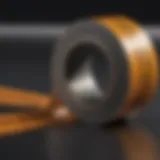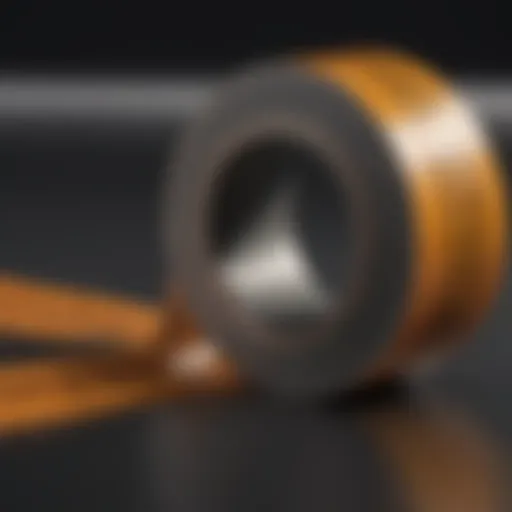Exploring Guardsman Filler Sticks: A Comprehensive Guide
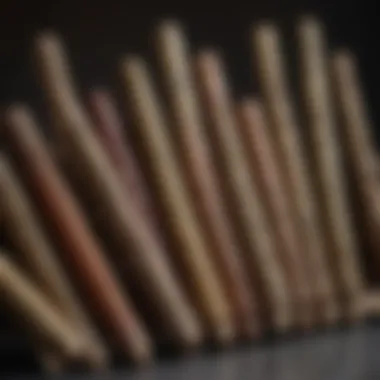

Intro
Home improvement is a widespread endeavor, often driven by a desire to enhance comfort and aesthetics in living spaces. Among the myriad of tools available to aid in this quest, Guardsman filler sticks hold a significant place. These may seem like simple products, but their role in furniture repair and restoration is quite profound.
Overview of Topic
Guardsman filler sticks serve as a vital solution for dealing with scratches, dents, and other surface blemishes that inevitably accumulate over time. Made from a mix of waxes, pigments, and resins, these sticks are designed to blend seamlessly with wood finishes, offering an efficient method for restoring the original appearance of furniture or other wooden items.
Why does this matter? Well, for homeowners, the state of furniture can be a reflection of the entire home’s aesthetic. A scratched table or a dented door can disrupt the visual harmony of a room. Therefore, understanding and utilizing these filler sticks can not only restore beauty but can also extend the life of your furnishings.
Common Challenges and Solutions
Despite the efficacy of Guardsman filler sticks, users may encounter several common challenges. Here are a few:
- Incorrect Color Match
It’s vital to select the right color for the surface you are repairing. - Smooth Application
Achieving a smooth finish can be tricky. Sometimes, the stick might not blend well, leading to visible patches. - Durability Issues
A repair job could look excellent right after application but may wear off quickly.
- Solution: Most brands, including Guardsman, offer a range of colors. It’s advisable to test a small portion before committing to a larger area.
- Solution: Instead of applying too much product at once, build it up gradually. Use a putty knife to smoothen out the application for a more seamless blend.
- Solution: After the filler has dried, consider applying a protective finish over it. This adds durability and can protect against future wear.
Product Recommendations
When it comes to efficient furniture repair, some products stand out in the market, including but not limited to the likes of Guardsman. Here are key products:
- Guardsman Filler Sticks
- Minwax Stainable Filler
- Howard Products
- Utilizes a unique blend of colors to achieve optimal match.
- Heat activated for easy application.
- Ideal for those looking to stain their repairs.
- Adheres well to wood, ensuring durability.
- Comes with a variety of shades to choose from.
- Excellent for larger repairs.
Step-by-Step Guides
To effectively use Guardsman filler sticks, here is a straightforward guide that can be beneficial for both novices and seasoned DIY enthusiasts:
- Identify the Damage
First, take a good look at the scratched or damaged area. Determine the depth and extent of the damage, so you know how much filler will be needed. - Select the Right Color
Use the color swatches provided by the manufacturer to find the best match for your furniture. This step can be crucial for achieving a natural look. - Clean the Area
Wipe the damaged area with a clean, dry cloth to remove any dust or debris. This ensures good adhesion. - Apply the Filler Stick
Gently rub the filler stick onto the damaged area. Use light pressure to avoid excess. - Smooth Out the Filler
Use a putty knife or your finger (protected with a glove) to smooth the surface, ensuring it blends well with the surrounding wood. - Allow to Dry
Let the filler set according to the manufacturer’s instructions before applying any protective finish. - Finishing Touches
If desired, consider sanding lightly after the filler has dried and then applying a protective coat to seal the repair.
Preface to Guardsman Filler Sticks
Understanding Guardsman filler sticks is crucial for anyone involved in furniture care, whether you’re a seasoned DIYer or a curious householder. These tools, designed to fill in scratches and blemishes, are essential in achieving the polished appearance of wooden surfaces. The simpler a solution is to wield, the more effective it can be in maintaining and enhancing the beauty of furniture without the hassles of extensive repairs.
Definition and Purpose
Guardsman filler sticks serve a clear purpose: they fill gaps and imperfections in wooden surfaces. Made from a specially formulated blend of waxes and pigments, these filler sticks blend seamlessly with wood finishes. This ensures that once applied, the correction is nearly invisible, allowing for a neat and professional touch to furniture.
For instance, if a chair leg sustains a nick during a family gathering, using a Guardsman filler stick can quickly restore its look. Within moments, such minor damages can be addressed effectively, saving time and costs that might have otherwise gone into professional repair services.
Additionally, these filler sticks come in a variety of colors, catering to different wood shades. It is this versatility that makes them a go-to product for many homeowners, simplifying the often frustrating experience of furniture maintenance.
Historical Context
The concept of using filler materials isn't new; artisans have employed various methods for ages to restore and maintain the integrity of wood. However, Guardsman has pioneered the formulation specifically focusing on ease of application and quality of results. From its early days, the brand positioned itself as a key player in the furniture protection market, appealing particularly to enthusiasts who value aesthetics and care for their belongings.
As households evolved and the demand for upkeep solutions grew, the use of these filler sticks became widespread. No longer reserved for professionals, these tools found their way into homes, empowering individuals to tackle small repairs themselves. The historical context of Guardsman filler sticks reflects a broader trend within home improvement—a move toward self-sufficiency where people prefer handling small repairs and problems on their own, fostering a sense of accomplishment and pride along the way.
"A scratch in the wood may seem like the end of the world, but with the right tools, there's always a way to turn back the clock."
In summary, the introduction of Guardsman filler sticks not only provides a practical solution to minor repairs but also symbolizes the growing trend of homeownership as a hands-on endeavor geared toward preservation and enhancement.
Material Composition of Guardsman Filler Sticks
Understanding the material composition of Guardsman filler sticks is essential for anyone invested in maintaining or restoring wooden furniture. The effectiveness of these filler sticks is deeply rooted in the unique blend of materials they contain, which directly influences their performance. By knowing what goes into these filling tools, users can better appreciate their benefits and make informed choices during repairs or creative projects.
Main Ingredients
Guardsman filler sticks boast a carefully curated mix of ingredients that serve different functionalities. Here's a breakdown of the primary components:
- Wax: The base of most filler sticks. Wax helps in achieving the right consistency and aids in smooth application, allowing the stick to glide over surfaces without too much resistance.
- Pigments: These are crucial for achieving the perfect color match with the wood you are repairing. Specific pigments offer a range of tones, making it easier to blend repairs seamlessly.
- Resins: A resin component provides firmness and durability to the filler once it dries, ensuring that the repaired area retains its integrity over time.
- Solvents: These help in keeping the filler soft and workable until application is complete. Once dried, their excess evaporates, leaving a strong, resilient repair.
When these ingredients coalesce, they yield a filler stick capable of addressing a myriad of imperfections, whether it be chips, scratches, or larger areas where the wood has been damaged.
Chemical Properties
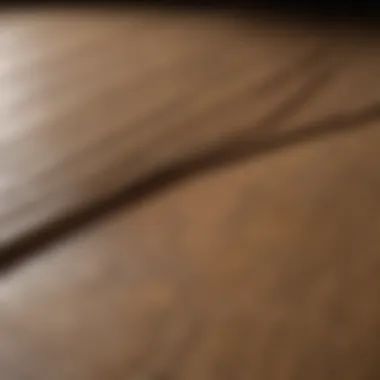

From a chemical standpoint, the composition of Guardsman filler sticks holds significant importance. Understanding their chemical properties can aid users in leveraging these tools in the most effective way possible.
- Adhesion: The fillers exhibit strong adhesive qualities. This property allows the filler to bond firmly with the wood, reducing the chances of cracking or peeling over time.
- Flexibility: When applied, the filler retains some flexibility. This is especially important in areas that might expand or contract with changes in humidity and temperature. Wood's natural movement won't easily dislodge the filler, which is beneficial in maintaining a lasting repair.
- Color Stability: The pigments within the sticks are formulated for stability, meaning they won’t fade or change color over time. This ensures that repairs remain visually coherent with the rest of the furniture.
- Solubility in Water: Once dried, these fillers become resistant to water. However, while they are still in a workable state, their solubility makes clean-up easier if necessary.
"Grasping the chemical nuances of filler sticks enhances their usability and effectiveness, ensuring that your repairs are both lasting and aesthetically pleasing."
In summary, the material composition of Guardsman filler sticks comprises a sophisticated blend that plays a pivotal role in its application and performance. By understanding the ingredients and chemical properties at play, users can approach their projects with greater confidence and skill.
Applications of Guardsman Filler Sticks
Guardsman filler sticks serve as a reliable solution for a variety of applications, making them indispensable tools for both professionals and home enthusiasts alike. Understanding their significance, particularly in contexts such as furniture repair, restoration projects, and crafting, can empower users to tackle their tasks with competence.
Furniture Repair
When it comes to furniture repair, Guardsman filler sticks are often the unsung heroes. They possess the unique ability to seamlessly fill in nicks, scratches, and other surface imperfections. Here's why this matters:
- Aesthetic Restoration: Restoring the visual integrity of furniture can enhance its lifespan. Using a filler stick to patch imperfections not only improves appearance, but it often saves a piece from being thrown out altogether.
- Cost-effectiveness: Replacing furniture is often out of reach for many. Utilizing filler sticks allows homeowners to utilize the items they already own without the larger expense of a replacement. This adds value to the home and keeps budgets in check.
- User-Friendly: For those who might be intimidated by more extensive furniture repairs, using a filler stick is straightforward. A simple application requires minimal tools and can yield remarkably professional-looking results.
In practical terms, think about a kitchen table marred by the occasional knife slip or a dining chair that bears the scars of years of use. In just a few swift motions, the filler stick makes these eyesores vanish, bringing back the harmony of the furniture’s appearance.
Restoration Projects
Restoration projects often call on the versatility of Guardsman filler sticks. Whether refitting old pieces or renovating a room, these sticks can play a crucial role in the process.
- Wood Finishing: During the remodeling phase, filled wood surfaces provide a solid foundation for staining and finishing. The filler effectively creates a smooth canvas, which is beneficial for achieving a polished look, free from distractions caused by blemishes.
- Historical Value: Restoring vintage furniture or heirlooms requires skill and sensitivity. Using a filler stick can help preserve the piece's historical integrity while maintaining its aesthetic value.
- Adaptability: Not limited to just wood, filler sticks work well with various materials, enabling creativity in application—from cabinets to wardrobes and beyond.
Imagine embarking on a DIY project where an antique cabinet needs help. A few strokes with a Guardsman filler stick can offer just what’s needed to bring the piece back to life, allowing for the nuances of its age to shine through, yet look as good as new.
Crafting and DIY Use
Beyond furniture repair and restoration, Guardsman filler sticks also find favor in the crafting world. They can serve multiple purposes in DIY projects, appealing to both amateur and seasoned crafters.
- Filling Gaps: In projects that involve building or repairing wooden structures, filler sticks can fill gaps and seams where materials meet. This minimizes the visual flaws that can detract from overall quality.
- Custom Finishes: Crafters can use these sticks in a myriad of ways to create custom finishes on furniture or decorative items, ensuring their creations are tailored to personal tastes.
- Versatile Applications: From creating models to enhancing decorative borders on picture frames, the applications are vast. A little imagination can turn a simple filler stick into a craft tool offering multiple functionalities.
As an example, a home craft enthusiast may decide to design a unique bookshelf. Utilizing a filler stick to cover nail holes or surface imperfections can lead to a finished product that exudes professionalism without heavy investment in specialized tools.
"A small detail can make a huge difference—filler sticks have become the go-to for many DIYers looking to elevate their projects."
Epilogue
Engaging with Guardsman filler sticks opens up a world of opportunities. Whether the goal is to restore, repair, or create, these tools present versatile solutions that help anyone—no matter their skill level—see their projects through to a satisfying conclusion. The applications not only enhance the aesthetic appeal of furniture and projects but offer functional benefits that extend lifetime and enjoyment, turning basic repairs into remarkable transformations.
Advantages of Using Guardsman Filler Sticks
When tackling furniture repairs or restoration projects, understanding the advantages of Guardsman filler sticks is crucial. These handy tools are designed to offer multiple benefits that can streamline your efforts and yield impressive results. Whether you’re a seasoned craftsman or a novice, knowing what these filler sticks bring to the table can make a significant difference in your projects.
Ease of Use
One of the standout features of Guardsman filler sticks is their remarkable ease of use. Unlike other filling compounds that may require mixing or precise application techniques, these filler sticks are straight to the point. Simply take the stick, rub it over the damaged area, and voilà!
This user-friendly approach is particularly appealing to housewives and homeowners who may not have extensive experience in repairs. No need to fumble with complicated instructions or tools. Just keep it simple:
- Convenience: Grab it, apply it, and move on. No waiting for drying or curing times between applications, which means less frustration in the process.
- Control: The solid form allows for better control compared to liquid fillers, making it safer and more effective for small or intricate repair jobs.
Durability and Longevity
Another vital aspect of Guardsman filler sticks is their impressive durability and longevity. Once applied, you can expect a strong bond that withstands everyday wear and tear. Unlike certain products that might crumble or fade over time, these sticks hold their ground.
Why are these qualities important? Consider the following points:
- Wear Resistance: They can endure stress and abuse from frequent use, ensuring your repairs last longer.
- Sustainability: A quick touch-up is oftentimes all it takes after years of use. This ultimately saves time and money in the long run.
"Investing in quality filler reduces not just repairs, but also future headaches!"
In essence, using Guardsman filler sticks equates to a long-term solution rather than a quick band-aid fix.
Color Variability
Lastly, the color variability of Guardsman filler sticks offers a substantial edge. You can find these sticks in a range of shades that closely match different wood finishes, so you’re less likely to end up with an eyesore of mismatched color. This becomes especially useful when dealing with intricate woodwork or vintage pieces that require careful restoration.
Here are some essential considerations regarding color variability:
- Seamless Repair: Having the right color can make repairs practically invisible, which is perfect for maintaining aesthetic appeal.
- Custom Blending: If you can’t find the perfect match, some users opt to blend different shades, creating a color that fits their needs exactly. This flexibility can be a game changer for unique pieces.
Overall, these advantages highlight why Guardsman filler sticks should be a go-to choice for anyone involved in DIY repairs or restoration projects. With their user-friendly nature, resilience, and variety of colors, they empower homeowners to achieve satisfying and lasting results.


Techniques for Using Guardsman Filler Sticks
When it comes to using Guardsman filler sticks, employing the right techniques can make a world of difference in the final result of your project. The techniques you choose not only influence the aesthetics of the repair but also its longevity and effectiveness. Mastering these methods allows you to achieve a seamless finish, ultimately elevating the furniture restoration process to a professional level. Let’s delve into the application methods and finishing touches that can set your work apart.
Application Methods
Direct Application
Direct application is the go-to method for many users and for good reason. This technique involves applying the filler stick directly to the area needing repair, allowing for a straightforward, hands-on approach. One of the key characteristics of direct application is simplicity; it requires no additional tools, making it an accessible choice for both seasoned pros and beginners.
The unique feature of direct application is its versatility. You can easily adjust the amount of filler applied and control the pressure with your fingers. This hands-on experience can help in blending the filler seamlessly into the surrounding surface. However, direct application can sometimes lead to uneven fills if not done carefully. It can be challenging to achieve the perfect smoothness without proper techniques, which can affect the overall appearance of the repair.
Using a Gun
Using a gun, specifically a caulking gun designed for filler sticks, opens up a different set of advantages. This method provides a controlled and continuous flow of material, which is ideal for larger or more intricate repairs. One major characteristic of using a gun is precision; the nozzle allows you to direct the filler exactly where you need it.
The unique feature of this technique is its efficiency. For tasks that require larger amounts of filler, this method gives you the power to lay down an even and consistent layer quickly. However, it does have its downsides. It may involve a bit more cleanup than direct application and requires some familiarity with the equipment to handle efficiently.
Finishing Touches
Once your filler has been applied, the finishing touches are essential for ensuring that the repair appears flawless and integrates well with the surrounding material. These final steps can significantly impact the visual appeal and durability of your restoration.
Sanding
When it comes to sanding, this technique cannot be overlooked. Sanding smooths the surface of the filler, ensuring that it matches the surrounding area. A key characteristic of sanding is its ability to create a seamless transition between the repaired spot and the rest of the furniture. It’s a popular choice because it provides a tactile refinement that is crucial in achieving a professional finish.
One of the unique features of sanding is its versatility in grit selection. You can start with a coarser grit to level the filled area, then finish with a finer grit to polish it to a smooth sheen. However, care must be taken not to over-sand, as this can damage the area surrounding the repair.
Polishing
Polishing is the cherry on top after sanding. This finishing technique enhances the appearance of the filler, restoring its luster and making it blend seamlessly with the wood. The key characteristic of polishing is its ability to bring out the depth of color in the wood, enhancing the overall look of the furniture. It's a beneficial choice because it not only improves aesthetics but also provides a layer of protection.
When polishing, consider using a clean, soft cloth in a circular motion to bring the filler to a shine. The unique feature of this technique is its transformative effect; it can turn a simple repair into a beautiful aspect of the furniture. On the flip side, excessive polishing can lead to build-up if not done correctly, which may detract from the natural look of the wood.
Overall, employing the right techniques while using Guardsman filler sticks not only helps in achieving a beautiful finish but also ensures that your repairs stand the test of time.
Maintenance of Guardsman Filler Sticks
Maintaining Guardsman filler sticks is an often overlooked, yet critical aspect that directly influences their effectiveness and longevity. Proper maintenance practices can ensure that these tools always deliver optimal results when they are needed most. With furniture restoration and repair projects frequently demanding precision, understanding how to care for filler sticks can significantly affect the quality of work and the satisfaction gleaned from it.
The nuances of maintenance extend beyond merely placing them in a drawer. Many factors can determine the successful usage of Guardsman filler sticks, including how they are stored, their shelf life, and signs that they may need replacing. Ignoring these elements can lead to frustrating experiences, particularly when the time comes to tackle a project with ill-prepared tools.
Storage Recommendations
How you store your filler sticks can greatly influence their performance. Ideally, these sticks should be kept in a cool, dry place away from direct sunlight. Here are some valuable tips for proper storage:
- Temperature Control: An environment that is too hot can cause filler sticks to soften, while extreme cold may make them brittle. Aim for a moderate temperature.
- Accessibility: Keep them in a designated toolbox or container, away from potential hazards like humidity or water exposure.
- Avoiding Pressure: Ensure they are stored upright or on a flat surface to prevent unnecessary pressure that can distort their shape.
In addition, consider labeling the storage container if you have multiple types or colors. This will save time and effort when you need to make a quick selection.
Shelf Life Considerations
Understanding the shelf life of Guardsman filler sticks is another critical element in their maintenance. While they can last quite a while, their effectiveness may diminish over time. Generally, an unopened stick can last several years, but this period can shorten once it has been exposed to air and contaminants. Generally, here’s what you should keep in mind about shelf life:
- Visual Inspection: Regularly check for any signs of discoloration, cracking, or unusual odors. If a stick seems off, it’s best to replace it.
- Stored Properly: Properly stored filler sticks are more likely to last longer. Following previously mentioned storage tips, regularly check these tools can help determine if they are still usable.
- Expiration Dates: If you look over your filling supplies and see an expiration date, take it seriously. Using them past the deadline can compromise the quality of your repairs.
It’s better to have a stock of reliable and fresh filler sticks on hand than to risk using expired materials in your next project.
By delving into the importance of maintenance, one can truly appreciate the role that meticulous care plays in maximizing the potential of Guardsman filler sticks. Investing time into storage and understanding shelf life can make all the difference when it comes to tackling furniture repair or restoration tasks.
Common Issues and Solutions
When it comes to using Guardsman filler sticks, being aware of common issues can save both time and frustration. Every tool has its pitfalls, and recognizing them can make a significant difference in the outcome. This section focuses on pivotal elements like cracking, shrinking, and color mismatch. Understanding these challenges allows homeowners and DIY enthusiasts to tackle them head-on, ensuring that their restoration or repair projects yield satisfying results.
Cracking and Shrinking
Cracking and shrinking can happen after the filler stick is applied but before it sets properly. Why does this occur? A significant factor is the moisture content in the material where you are applying the filler stick. For example, if the wood is particularly damp, this can lead to uneven drying and potential cracking.
To minimize these issues, consider the following tips:
- Check for moisture: Always assess the wood's moisture before applying the filler. If the wood feels damp, it’s better to wait for it to dry.
- Apply in thin layers: Rather than trying to fill a deep gap all at once, applying thin layers can help prevent large cracks as it dries. This allows for a more even setting.
- Avoid extreme temperatures: Hot or cold environments can affect how the filler dries. Aim for a moderate temperature during application.
If cracking or shrinking does occur, you can address it by:
- Reapplying filler: Depending on how extensive the cracks are, sometimes, simply adding more filler can solve the problem. Make sure to synchronize the color as best as you can.
- Sanding: Carefully sanding down the area may provide a smoother finish, allowing the newly applied filler to blend seamlessly with the existing wood.
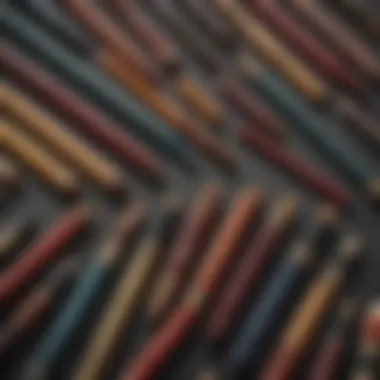

"A stitch in time saves nine; addressing these issues early can save a lot of frustration later."
Color Mismatch
Color mismatch can be another frustrating problem when utilizing Guardsman filler sticks. Once applied, the filler may not blend precisely with the surrounding material, leading to an unsightly appearance.
Here are some reasons this might happen:
- Filler oxidation: Over time, the filler can change color due to exposure to air and environmental factors.
- Wrong selection: If the filler color doesn’t match the existing wood stain or finish, the result can be glaring.
To tackle color mismatches, keep the following strategies in your arsenal:
- Test before full application: Always try the color on a less visible spot first. This can save a lot of hassle and ensure a closer match.
- Mix and match: If you’re working with multiple sticks, consider mixing shades to achieve a better overall match. This is often how experienced crafters blend colors effectively.
- Post-application staining: Once the filler dries, you might find it beneficial to apply a matching stain over it. This can often camouflage any subtle differences.
Comparative Analysis with Other Filling Products
When discussing the versatility of filling products, it's essential to delve into a comparative analysis that sheds light on how Guardsman filler sticks stack up against other options on the market. Understanding these distinctions not only aids in making informed decisions but also helps one appreciate the unique attributes of filler sticks in context, enhancing their overall effectiveness in various applications.
Wood Putty vs. Filler Sticks
When comparing wood putty and filler sticks, there are several aspects to consider, ranging from application ease to durability. Wood putty, often used for filling larger gaps in unfinished wood, can lack the adaptability of filling sticks. It generally requires a longer drying time, while Guardsman filler sticks can be applied directly from the stick, streamlining the process. Households frequently rely on wood putty for structural repairs; however, this product can sometimes shrink as it dries, leading to a less-than-desirable finish. In contrast, filler sticks maintain their form better after application, reducing the need for multiple rounds of filling during the project.
Moreover, wood putty often comes in fewer colors, necessitating mixing or tinting for a matching finish—a frustrating endeavor for many. On the other hand, Guardsman filler sticks offer a wide range of color options that can be seamlessly blended, ensuring that one can find the right hue to harmonize with their furniture or repair project.
Epoxy vs. Filler Sticks
The comparison between epoxy and filler sticks is another important junction to consider. Epoxy products are renowned for their strength and adhesive properties, making them ideal for heavy-duty repairs. However, they require a more complex application process, including measuring and mixing components as per instructions. This can be a turn-off for housewives or homeowners looking for straightforward solutions. In contrast, using Guardsman filler sticks is as simple as applying the material straight from the tube, making it accessible for a quicker fix.
Epoxy tends to dry hard and rigid, which, while beneficial in some scenarios, may not meld well with softer woods that need a degree of flex. Filler sticks, with their composition, can offer a more natural 'give' that suits various furniture types, such as antiques or delicate pieces. In addition, while epoxy is often praised for its resistance to moisture, it can be tricky when it comes to rework—once it’s set, it’s quite the task to reshape or paint over it. In contrast, filler sticks allow for easier touch-ups and adjustments, providing flexibility that many DIY enthusiasts appreciate.
Ultimately, making a choice between wood putty, epoxy, and Guardsman filler sticks largely depends on the specific requirements of each repair project. Understanding these differences can empower homeowners to select the most effective product for their needs, leading to better results with less time and hassle.
"Every project is unique. What works for one situation may not be the best for another. Make your choices wisely!"
Choosing the Right Filler Stick
Choosing the right filler stick can be the difference between a project that looks polished and one that falls short of its potential. It's not just about fixing a crack or gap; it's about ensuring that the repair blends seamlessly with the surrounding surface. Selecting the appropriate product speaks volumes about your attention to detail and commitment to quality.
What’s more, the right filler stick can also save time and effort down the line. Using an incompatible product could lead to recurring issues, such as cracking or color mismatch, thus compelling you to redo the job. So, understanding the various aspects of what makes a filler stick suitable for your specific needs is essential.
Factors to Consider
When it comes to choosing a filler stick, several factors come into play:
- Material Compatibility: The filler stick should ideally match the material you are repairing. For instance, using a wood filler on laminate furniture may not yield the desired result. Check whether it's formulated for the type of wood or surface you're working on.
- Color Match: It's vital to pick a color that blends into the existing surface. Some brands offer a wide selection of colors; consider grabbing a few samples before you commit to a large repair job.
- Drying Time: How long does it take to dry? Some filler sticks set quickly, while others may take longer, impacting your project timeline. If the job is time-sensitive, choose one that dries fast.
- Ease of Application: Some filler sticks are designed for straightforward application, while others may require specialized tools. Think about your comfort level and skill when it comes to tool use.
- Durability: Look for products that are resistant to cracking and wear. A filler stick that stands up well over time will save you the hassle of frequent repairs.
Understanding these factors can steer you in the right direction, ensuring that you pick a filler stick that not only meets but exceeds your expectations.
Brand Selection
Selecting the right brand can also play a significant role in your results. Not all filler sticks are created equal, and some brands have carved out a niche for themselves through quality and reliability.
- Reputation: Look for brands that have established themselves in the market for their dependability. Consumer reviews can provide valuable insights into the effectiveness of a brand.
- Expert Endorsements: Industry professionals often have their favorites based on experience. Recommendations from trusted sources can guide your choices.
- Product Range: A brand that offers various fillers may be beneficial. If you become a regular user, having multiple options from a single source can simplify your projects. For instance, a brand that specializes in wood repairs might also offer fillers for other materials, allowing for easier transitions.
- Price Point: While you don’t want to skimp on quality, it’s also wise not to overspend. Explore options that fit within your budget but offer a balance between cost and performance.
In a nutshell, making an informed choice about the filler stick you select involves considering various aspects across both the product specifications and the brand reputation. This careful approach can empower you to tackle your repair projects with confidence, ensuring a finish you can be proud of.
The End and Future Perspectives
In closing, this guide to Guardsman filler sticks doesn't just serve as a playbook for using these tools, but also shines a spotlight on their long-term value in the realm of furniture repair and restoration.
Understanding how to select, use, and maintain filler sticks can significantly extend the life of furniture pieces, turning even the roughest surfaces back into seamless beauties. Moving into the future, we see a growing trend towards environmentally friendly options in furniture care, which raises intriguing possibilities for the evolution of filler stick technology.
Summary of Insights
So, what have we learned? First, the versatility and user-friendliness of Guardsman filler sticks make them indispensable for any homeowner or DIY enthusiast. They are easy to apply and can cover up many imperfections effectively. Their composition allows them to bond well with various surfaces, ensuring that your repair will stand the test of time. Additionally, the wide color range allows for easy blending, mitigating any concerns about mismatches in hues.
Key takeaways include:
- Ease of Use: Perfect for beginners and experienced users alike.
- Durability: Well-suited for various applications beyond just wood repair.
- Color Matching: A variety of color options makes blending a breeze.
Innovations in Filler Technology
Innovations have begun to surface in the field of filler technology. New formulations are being introduced that include eco-friendly materials aimed at reducing environmental impact. These cater to a growing customer base that values sustainability without sacrificing performance.
Future trends may include:
- Biodegradable formulas: Filling that breaks down environmentally, reducing pollution.
- Color-matching technology: Systems that help users find the right shade without guesswork.
- Advanced adhesion properties: Allowing for quicker application and faster drying times.
”The future of filler technology hinges on blending performance with sustainability, ensuring homeowners can protect their investments without compromising their values.”
As we move forward, homeowners can expect not just improvements in existing filler stick products but perhaps entirely new approaches to wood repair and restoration. Navigating these advancements will not only enhance one's abilities in DIY projects but also correlate positively with the care of beloved furniture pieces. Whether preserving a family heirloom or engaging in a creative project, staying informed will empower individuals to make choices that align with both functionality and ethics.




